Monographs: Pharmaceutical substances: Lopinavir (Lopinavirum)
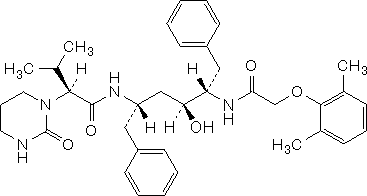
C37H48N4O5
Relative molecular mass. 628.8
Chemical name. (2S)-N-[(1S,3S,4S)-1-benzyl-4-{[(2,6-dimethylphenoxy)acetyl]amino}-3-hydroxy-5-phenylpentyl]-3-methyl-2-(2-oxotetrahydropyrimidin-1(2H)-yl)butanamide; CAS Reg. No. 192725-17-0.
Description. A white or almost white powder.
Solubility. Freely soluble in methanol and dichloromethane, practically insoluble in water.
Category. Antiretroviral (Protease Inhibitor).
Storage. Lopinavir should be kept in a tightly closed container, protected from light.
Additional information. Lopinavir is hygroscopic and is usually obtained in a hydrated form ; it may exhibit polymorphism.
Requirements
Definition. Lopinavir contains not less than 98.5% and not more than 101.5% of lopinavir (C37H48N4O5), calculated with reference to the anhydrous substance.
Identity tests
• Either test A alone or tests B and C may be applied.
A. Carry out the examination as described under 1.7 Spectrophotometry in the infrared region. The infrared absorption spectrum is concordant with the spectrum obtained from lopinavir RS or with the reference spectrum of lopinavir. If the spectra thus obtained are not concordant, repeat the test using the residues obtained by separately dissolving the test substance and lopinavir RS in a small amount of methanol R and evaporating to dryness. The infrared absorption spectrum is concordant with the spectrum obtained from lopinavir RS.
B. Carry out test B.1 or, where UV detection is not available, test B.2.
B.1 Carry out the test as described under 1.14.1 Chromatography, Thin-layer chromatography, using silica gel R6 as the coating substance and a mixture of 95 volumes of dichloromethane R and 5 volumes of methanol R as the mobile phase. Apply separately to the plate 10 μl of each of 2 solutions in methanol R containing (A) 5 mg of the test substance per mL and (B) 5 mg of lopinavir RS per mL. After removing the plate from the chromatographic chamber, allow it to dry exhaustively in air or in a current of cool air. Examine the chromatogram in ultraviolet light (254 nm).
The principal spot obtained with solution A corresponds in position, appearance, and intensity with that obtained with solution B.
B.2 Carry out the test as described under 1.14.1 Chromatography, Thin-layer chromatography, using the conditions described above under test A.1 but using silica gel R5 as the coating substance, spray with basic potassium permanganate (5 g/l) TS. Examine the chromatogram in daylight.
The principal spot obtained with solution A corresponds in position, appearance, and intensity with that obtained with solution B.
C. The absorption spectrum (1.6) of a 0.75 mg/mL solution in methanol R, when observed between 230 nm and 350 nm, exhibits one maximum at about 260 nm and shoulders at around 255 and 265 nm. The specific absorbance at 260 nm (
) is 9.0 to 10.0.
Specific optical rotation (1.4). Use a 8.0 mg/mL solution in methanol and calculate with reference to the anhydrous substance;  = -22.0° to -33.0°.
= -22.0° to -33.0°.
Water. Determine as described under 2.8 Determination of water by the Karl Fischer method, Method A, using about 0.1 g of the substance; the water content is not more than 50 mg/g.
Heavy metals. Use 1.0 g for the preparation of the test solution as described under 2.2.3 Limit test for heavy metals, Procedure 3; determine the heavy metals content according to Method A; not more than 20 μg/g.
Sulfated ash (2.3). Not more than 2.0 mg/g.
Related substances. Carry out the test as described under 1.14.1 Chromatography, High-performance liquid chromatography, using a stainless steel column (25 cm x 4.6 mm) packed with base-deactivated particles of silica gel the surface of which has been modified with chemically bonded octadecylsilyl groups (5 μm).
The mobile phases for the gradient elution consist of a mixture of Mobile phase A and Mobile phase B, using the following conditions:
Mobile phase A: 30 volumes of acetonitrile R, 20 volumes of phosphate buffer pH 2.5 and 50 volumes of water R.
Mobile phase B: 80 volumes of acetonitrile R and 20 volumes of phosphate buffer pH 2.5.
Prepare the phosphate buffer pH 2.5 by dissolving 2.72 g of potassium dihydrogen phosphate R in 800 mL of water R and adjust the pH to 2.5 by adding phosphoric acid (~105 g/l) and dilute to 1000 mL with water R.
|
Time |
Mobile phase A |
Mobile phase B |
Comments |
|
0 – 3 |
100 |
0 |
Isocratic |
|
3 – 30 |
100 to 20 |
0 to 80 |
Linear gradient |
|
30 – 40 |
20 to 0 |
80 to 100 |
Linear gradient |
|
40 – 50 |
0 |
100 |
Isocratic |
|
50 – 51 |
0 to 100 |
100 to 0 |
Return to initial composition |
|
51 – 70 |
100 |
0 |
Re-equilibration |
Prepare the following solutions using mobile phase A as diluent. For solution (1) use 1.0 mg of the test substance per mL. For solution (2) dilute a suitable volume of solution (1) to obtain a concentration equivalent to 10 μg of lopinavir per mL.
For the system suitability test: prepare solution (3) using 5 mL of solution (1) and 2 mL of hydrochloric acid (1 mol/l) VS, heat carefully in a boiling water-bath for 30 minutes.
Operate with a flow rate of 1.0 mL per minute. As a detector use an ultraviolet spectrophotometer set at a wavelength of 210 nm.
Inject 20 μl of solution (3). The test is not valid unless the resolution between the peak due to lopinavir (retention time about 26 minutes) and the peak with a relative retention of about 0.6 is at least 10.
Inject alternatively 20 μl each of solutions (1) and (2).
In the chromatogram obtained with solution (1), the area of any peak, other than the principal peak, is not greater than 0.3 times the area of the principal peak obtained with solution (2) (0.3%). The sum of the areas of all peaks, other than the principal peak, is not greater than the area of the principal peak obtained with solution (2) (1.0%). Disregard any peak with an area less than 0.05 times the area of the principal peak in the chromatogram obtained with solution (2) (0.05%).
Assay
Dissolve 0.50 g, accurately weighed, in 40 mL of a mixture of equal volumes of glacial acetic acid R1 and acetic anhydride R. Titrate with perchloric acid (0.1 mol/l) VS and determine the end point potentiometrically as described under 2.6 Non-aqueous titration, Method A. Each mL of perchloric acid (0.1 mol/l) VS is equivalent to 62.88 mg of lopinavir (C37H48N4O5).
Impurities
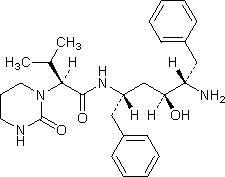
A. (2S)-N-[(1S,3S,4S)-4-amino-1-benzyl-3-hydroxy-5-phenylpentyl]-3-methyl-2-(2-oxotetrahydropyrimidin-1(2H)-yl)butanamide (lopinavir amino alcohol),

B. (2,6-dimethylphenoxy)acetic acid,
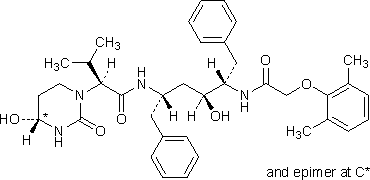
C. (2S)-N-[(1S,3S,4S)-1-benzyl-4-{[(2,6-dimethylphenoxy)acetyl]amino}-3-hydroxy-5-phenylpentyl]-2-[(4RS)-4-hydroxy-2-oxotetrahydropyrimidin-1(2H)-yl]-3-methylbutanamide (4-hydroxylopinavir),
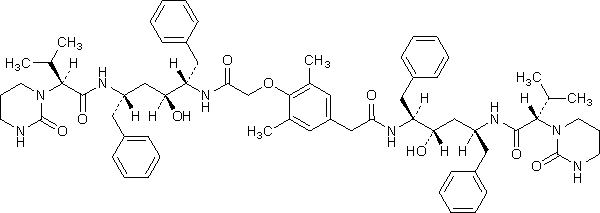
D. (2S)-N-[(1S,3S,4S)-1-benzyl-4-({[4-(2-{[(1S,2S,4S)-1-benzyl-2-hydroxy-4-{[(2S)-3-methyl-2-(2-oxotetrahydropyrimidin-1(2H)-yl)butanoyl]amino}-5-phenylpentyl]amino}-2-oxoethyl)-2,6-dimethylphenoxy]acetyl}amino)-3-hydroxy-5-phenylpentyl]-3-methyl-2-(2-oxotetrahydropyrimidin-1(2H)-yl)butanamide (carboxymethyl analogue),
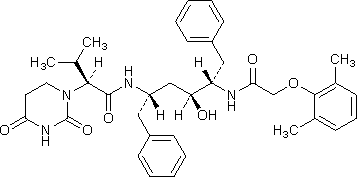
E. (2S)-N-[(1S,3S,4S)-1-benzyl-4-{[(2,6-dimethylphenoxy)acetyl]amino}-3-hydroxy-5-phenylpentyl]-2-[4-hydroxy-2,4-dioxotetrahydropyrimidin-1(2H)-yl]-3-methylbutanamide (4-oxolopinavir),
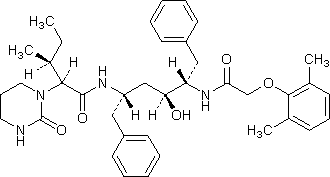
F. (2S,3S)-N-[(1S,3S,4S)-1-benzyl-4-{[(2,6-dimethylphenoxy)acetyl]amino}-3-hydroxy-5-phenylpentyl]-3-methyl-2-(2-oxotetrahydropyrimidin-1(2H)-yl)pentanamide (lopinavir isoleucine analogue),
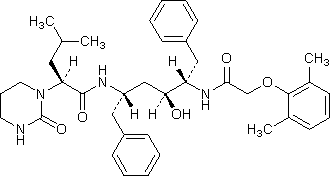
G. (2S)-N-[(1S,3S,4S)-1-benzyl-4-{[(2,6-dimethylphenoxy)acetyl]amino}-3-hydroxy-5-phenylpentyl]-4-methyl-2-(2-oxotetrahydropyrimidin-1(2H)-yl)pentanamide (lopinavir leucine analogue),
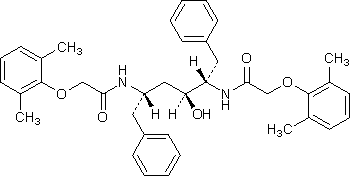
H. N,N'-[(2S,3S,5S)-3-hydroxy1,6-diphenylhexane-2,5-diyl]bis[2-(2,6-dimethylphenoxy)acetamide] (lopinavir diamide),
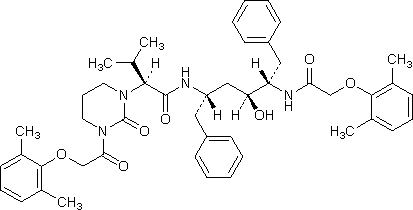
I. (2S)-N-[(1S,3S,4S)-1-benzyl-4-{[(2,6-dimethylphenoxy)acetyl]amino}-3-hydroxy-5-phenylpentyl]-2-{3-[(2,6-dimethylphenoxy)acetyl]-2-oxotetrahydropyrimidin-1(2H)-yl}-3-methylbutanamide (diacylated lopinavir).